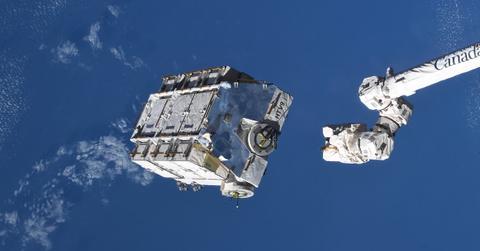NASA Launches 2.9-Ton Bundle of Space Junk Into Orbit
Updated March 17 2021, 2:07 p.m. ET

Littering isn’t just a problem here on Earth — it’s also an issue in outer space. Last week, following orders from NASA, the International Space Station released a 2.9-ton pile of space junk into low Earth orbit, where it will remain for several years before entering the atmosphere.
Is littering in space as bad as littering on Earth? Keep reading to hear about the International Space Station’s latest trash launch, and for everything you need to know about “space junk.”
NASA just launched a huge bundle of space junk into orbit.
As reported by Spaceflight Now, between 2017 and 2020, several dozen lithium-ion power storage units were delivered to the International Space Station (ISS), which astronauts used to replace out-of-date nickel-hydrogen power packs. Over the years, astronauts who visited the ISS replaced the batteries, and mounted the old ones onto HTV cargo pallets.
In May 2020, one of Japan’s cargo ships brought an external pallet to the International Space Station, and astronauts loaded it up with all the old nickel-hydrogen batteries. Then, on Thursday, March 11, ground controllers directed the ISS to release the cargo pallet into orbit. NASA predicts that the pallet will remain in orbit for about two to four years, after which it will reenter the Earth’s atmosphere and burn up.
The space junk pallet weighs about 2.9 tons, and is approximately the size of a large SUV, according to NASA. This is the largest bundle of space junk that the ISS has dropped since 2007, as per Gizmodo.
What exactly is space junk?
As explained by NASA, space junk, also known as space debris or orbital debris, is fragments of old spacecrafts, satellites, rocket parts, batteries, and other technology that humans send into space, that occupy space in low Earth orbit (LEO).
How much space junk is there?
There are millions of pieces of space junk flying in LEO, representing an estimated 6,000 tons — much of which moves at high speeds up to 18,000 miles per hour, as per NASA.
Like trash on Earth, space junk is a problem.
While there are plenty of rules on Earth telling humans to properly dispose of trash, no such rules exist in space — according to NASA, there aren’t any space laws governing the disposal of space junk, nor are there any regulations requiring the cleanup of the millions of pieces currently flying through LEO.
According to London’s Natural History Museum (NHM), the United Nations does request that those who launch satellites into space remove their satellites from orbit within 25 years of their mission ending — but rules like this have been difficult to enforce.
The U.S. government’s Space Surveillance Network tracks space junk, as per National Geographic — but it’s non-trackable space debris (typically smaller pieces) that are more likely to collide with satellites, according to Nicholas Johnson, NASA chief scientist for orbital debris.
While space junk poses a serious risk to satellites in orbit, it only poses a small risk to space travelers, according to the NHM. However, space junk does present a risk to us down on Earth. There have been several recorded instances over the past five decades in which space debris fell from LEO and landed on Earth — and in some instances, the debris actually injured humans.
Fortunately, many groups are hard at work to develop ways to clean up space debris. Hopefully more solutions will be implemented in the near future.